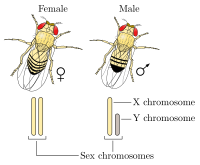
Photo from wikipedia
Abstract Habitat loss and pollution are two of the greatest global threats to biodiversity. Due to their widespread prevalence, these threats often co-occur, yet their interactive effects on organisms remain… Click to show full abstract
Abstract Habitat loss and pollution are two of the greatest global threats to biodiversity. Due to their widespread prevalence, these threats often co-occur, yet their interactive effects on organisms remain poorly understood. Some reptiles are vulnerable to these threats because they have specific microclimate requirements for embryonic development and because pollutants are maternally transferred to their eggs; both incubation temperature and pollutants affect reptile sex determination. In aquatic turtles, females often select nest sites in recently planted agricultural fields but the impact of nesting in polluted agricultural habitats is not understood. We examined the influences of crop agriculture and mercury pollution on nest microclimate and offspring sex ratios of Chelydra serpentina . We hypothesized that crop growth in agricultural fields would shade and cool turtle nests, decrease moisture levels, increase male offspring production, and interact with maternally-derived mercury to impact sex determination. As predicted, nests shaded by crops had lower average temperatures (−2.5 °C) and moisture levels (−107 kPa) than control nests. In field and laboratory experiments, agricultural thermal regimens increased the proportion of male offspring in clutches and this effect was intensified in the presence of mercury. Global temperatures are expected to rise within the 21st century and to have a feminizing effect on reptiles with temperature-dependent sex determination. That prediction should be refined to incorporate how the cooling effect of some local habitat conditions (e.g., agricultural fields), and interactions between anthropogenic land-use and common pollutants, will interact with climate change to influence sex ratios of reptiles with temperature-dependent sex determination.
Journal Title: Biological Conservation
Year Published: 2018
Link to full text (if available)
Share on Social Media: Sign Up to like & get
recommendations!